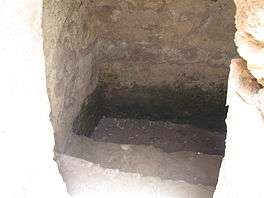Hurvat Itri
| חורבת עתרי | |
|
Archaeological remains at Hurvat Itri | |
| Location |
|
|---|---|
| History | |
| Periods | Second Temple era |
| Site notes | |
| Public access | Open year round |
Coordinates: 31°38′58″N 34°58′19″E / 31.6494720°N 34.9720070°E Hurvat Itri (Hebrew: חורבת עתרי) also known as the Itri Ruins (alt. spellings: 'Ethri; Atari), refers to a sprawling archaeological site that features the remains of a Jewish village which dates back to the Second Temple period. The site sits upon an elevation of 406 metres (1,332 ft) above sea level, wherein are preserved an ancient synagogue, wine presses, a theater, cisterns, ritual baths and stone ossuaries, as well as an underground system of public hiding places. The site is located in modern day Israel and is situated in the Judean Hills, southeast of Bet Shemesh, within the Adullam-France Park — c. 35 kilometers (22 mi) southwest of Jerusalem, 5 kilometers (3.1 mi) southeast of the Elah Valley and 8 kilometers (5.0 mi) northeast of Beth Guvrin. Formerly known as Umm Suweid (the mother of the buckthorns), the modern name of the site was only applied in March of 2001 by the Israel Official Names Commission, after a team of IAA archaeologists discovered an ostracon bearing the name "Ethri," thought to be a reference to the name of the city "Caphethra" (=Kefar Ethra) described by Josephus.[1] The site stands out among other archaeological sites because of its formidable wall formations, with massive stones, which led Israeli archaeologist, Boaz Zissu, to believe that it may have been one of the fifty strongholds in Judea destroyed by Hadrian during the second Jewish revolt (the Great Revolt).
The Judean Hills were first settled by the Israelite tribe of Judah during 12th century BCE and then became densely populated by the Jewish people between (1st century BCE – 1st century CE). At the time of the Great Revolt (66 CE-74 CE) of the Jews against the Roman rulers the Romans took over the hills and destroyed many of the villages and towns. Despite the revolt Jewish people returned and rebuilt their villages. Then came a second revolt also known as the Bar Kokhba Revolt which lasted from 132-135 CE. In which the Jews attacked the Romans using underground tunnels. In the end Jewish population was beaten and their villages and towns were destroyed.[2][3][4]
Archaeology
Archaeological findings at the site reveal that its inhabitants had several sources of income, namely, a columbarium facility for breeding doves and producing fertilizer, and loom and spindle weights for spinning and weaving. However, most, it would seem, produced wine from the locally produced vintage grapes, judging by its numerous wine presses. Archaeological artifacts and ruins have been found dating back to the Persian, Hellenistic and Early Roman periods.[5]
Of special interest were the discoveries of small coins from the second and third year of the First Jewish revolt, particularly, a silver half-shekel coin from the 3rd year of the revolt, upon which are embossed the words "Half-Shekel" in paleo-Hebrew (Hebrew: חצי השקל), and having a silver content of 6.87 grams, discovered in an area of the site known as "complex XIV," and a bronze coin with a date-palm tree and the inscription, "El'azar the Priest," and on its reverse side a bunch of grapes with the inscription: "Year One of the Freedom of Israel."[6][7]
Gallery
- Recreation of what some of the structures may have looked like.
- Archaeological remains.
 Ancient Jewish Mikveh uncovered at the site.
Ancient Jewish Mikveh uncovered at the site.
See also
References
- ↑ See Josephus, The Jewish War, 4.9.9, where the name is rendered in Greek as Κάφεθρα, believed to be a corruption of "Kefar Ethra. Cf. Boaz Zissu and Amir Ganor, Horvat 'Ethri— A Jewish Village from the Second Temple Period and the Bar Kokhva Revolt in the Judean Foothills, Journal of Jewish Studies, vol. LX, no. 1, Spring 2009, p. 90, note 1.
- ↑ JWeekly (28 May 2004). "Raiders of the lost synagogue:Ancient village opens to keep grave robbers away". JWeekly.com.
- ↑ https://books.google.com/books?hl=en&lr=&id=CcjYAQAAQBAJ&oi=fnd&pg=PA191&dq=hurvat+itri&ots=QUiSYlVj7t&sig=9jZc1qxfMwpz6645FwgqS_ZvPuI#v=onepage&q=hurvat%20itri&f=false
- ↑ http://www.dailyjews.com/articles/101_hiking_in_israel.htm
- ↑ Boaz Zissu & Amir Ganor, Horvat Ethri — A Jewish Village from the Second Temple Period and the Bar Kokhba Revolt in the Judean Foothills, Journal of Jewish Studies 60 (1), Oxford Centre for Hebrew and Jewish Studies, London 2009, pp. 92—96.
- ↑ Boaz Zissu & Amir Ganor, Horvat Ethri — A Jewish Village from the Second Temple Period and the Bar Kokhba Revolt in the Judean Foothills, Journal of Jewish Studies 60 (1), Oxford Centre for Hebrew and Jewish Studies, London 2009, pp. 96; 118.
- ↑ Boaz Zissu and Amos Kloner, Rock-Cut Hiding Complexes from the Roman Period in Israel (expanded and improved version of article published by Kloner and Zissu 2009), fig. 28 on p. 17 in pdf.
External links
- "Village Razed, Revel Beheaded" - Biblical Archaeology Review (2007)
- Horbat Ethri: Final Report, by Boaz Zissu
- Ethri
| Wikimedia Commons has media related to Hurvat Itri. |